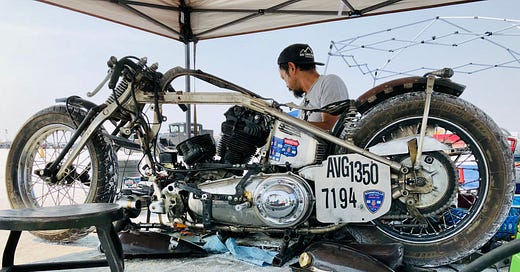
Where does our fascination with motorsports racing come from, and why are so many drawn to the famous Bonneville Salt Flats? Similar to a bicycle time trial, it’s human and machine against the clock, with every technical advantage taken within the spirit of the rules.
Henri and I experienced the majesty of Bonneville in 2018, and plan to return with Jean this year to support our friend Torsten Robbens in his first attempt on the legendary ‘white desert’ between Salt Lake City and Wendover, Utah in late September.
My family and I became acquainted with Bonneville after watching Anthony Hopkins portray Burt Monro in The World’s Fastest Indian feature film after we arrived in California from Ohio in 2006. Then we crossed the threshold of custom motorcycles through The Greasy Hands Preachers documentary in 2015, where the names Roland Sands, Shinya Kimura, David Borras, Michael ‘Woolie” Woolaway and others entered our wide-eyed world. The impact on me was so dramatic, I left the bicycle industry after nearly 25 years and switched hard to motorcycles at 49.
During our recent podcast session with Torsten, he explained his desire to race at Bonneville. As someone with stellar results organizing and managing others to success at the 24 Hours of Le Mans and the Isle of Man TT, Torsten, 49, decided it was his turn. The salt flats were calling.
We spoke via WhatsApp recently as our conversations and plans started to gel. I asked him about his motivation from my workshop in Mountain View, California as he sat in his office in Oudenaarde, Belgium.
What prompted you to consider racing the clock at the Bonneville Salt Flats? When did this dream begin?
My fascination for the technical evolution of racing cars and bikes from the interbellum period plays a huge part in this. It is as much about the machines as it is about the people like Sir Malcom Campbell and later his son Donald, but also the American hotrodders who built the most incredible machines in their garages.
From the bikes, there is of course the well known story of Burt Munro, who also inspired another of my all time heroes, John Britten. Watching the documentary of John Britten on VHS – and visiting the Britten museum in New Zealand – was the single most important thing to start building my own bikes. As John Britten's machines also set multiple landspeed records, it was always in the plans, and for me Bonneville is the place to do it.
Which bike/class record are you aiming for?
From the start it was very clear for me that this is a huge learning curve and that one has to respect the salt and be patient. Not the fastest, but purest category for me is the non-streamlined category. I will do this with a purpose-built electric motorcycle, integrating technical solutions from my previous designs, but pushing the envelope even more. That is one of the greatest things about land speed racing: the rules are very few, and mainly for safety. This leaves a lot of room for creativity, especially in the non-streamlined categories.
What does your timeline and preparation look like?
The design phase is pretty complete and the first prototype parts are being made. Shake downs will be done on a local airstrip here in Belgium, after which I would like to do high speed testing in the UK. If all goes well, later this summer will be the first attempts on the legendary Bonneville Salt Flats. Logistics is of course as much of a challenge as actually building and racing the bike.
This is a long term plan, and seeing a lot of older racers going there, I think there is a lot to learn from them.
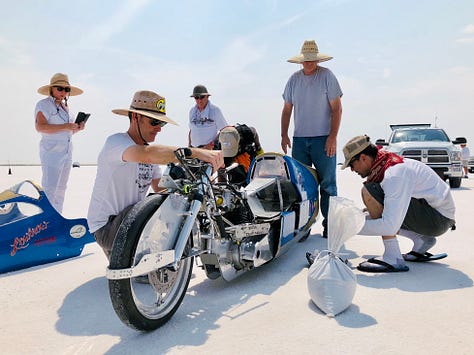

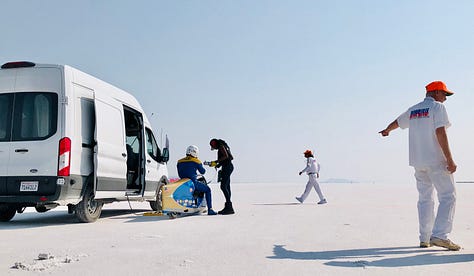
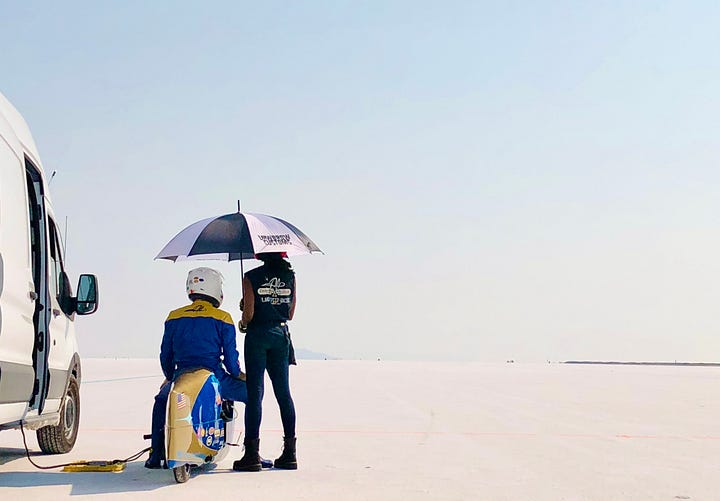
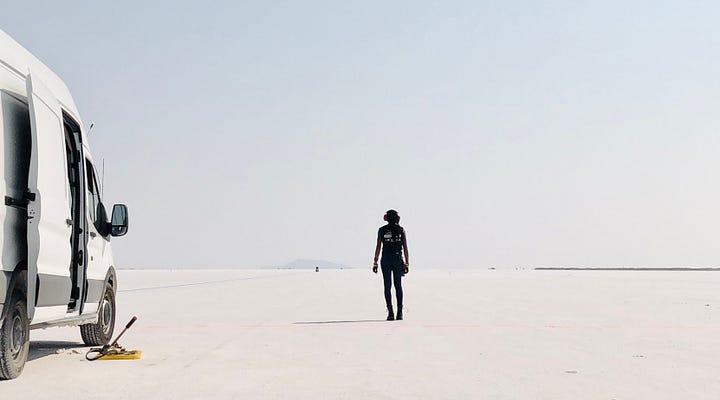
Torsten and I talked at length about the two days Henri and I spent on the salt with Alp Sungurtekin; BryanThompson; Shinya Kimura; and Stacie B. London in August 2018. The camaraderie was instant, with friendships cemented at first handshakes. Everyone’s there to help; spectating seems lazy.
Torsten has been consulting with Alp and Bryan about his preparations and approach to the salt. Alp has raced and built bikes for others, setting records along the way. Bryan raced on a bike he co-built with Alp in 2019.
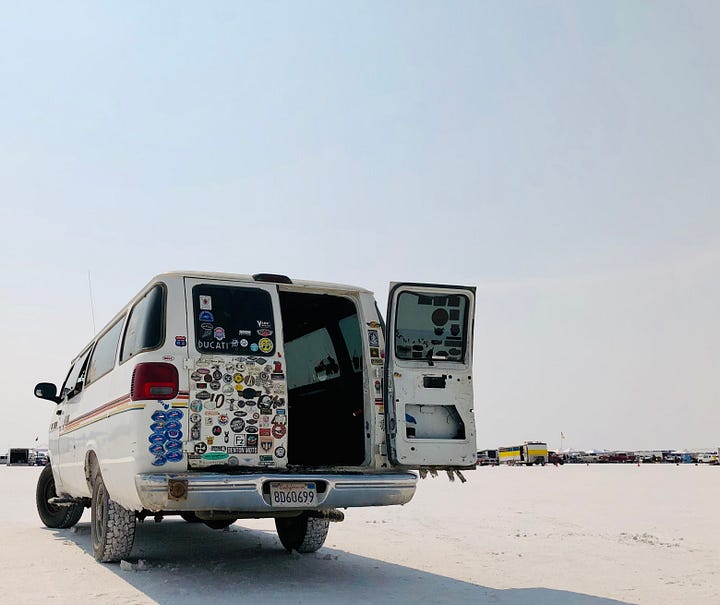
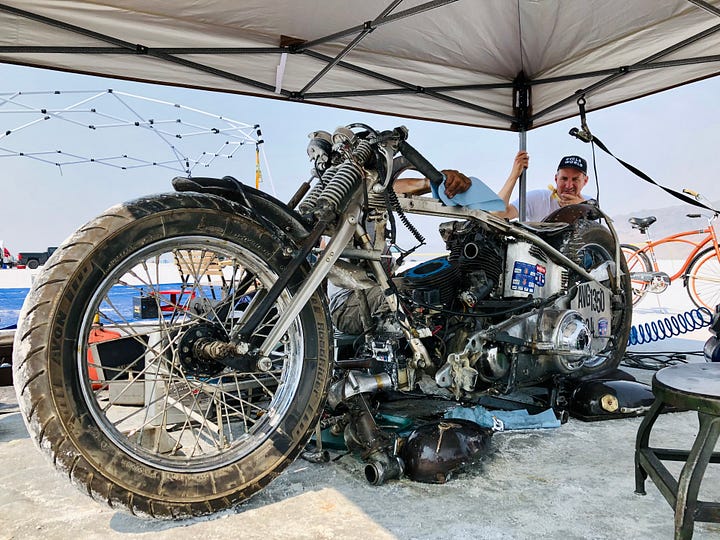
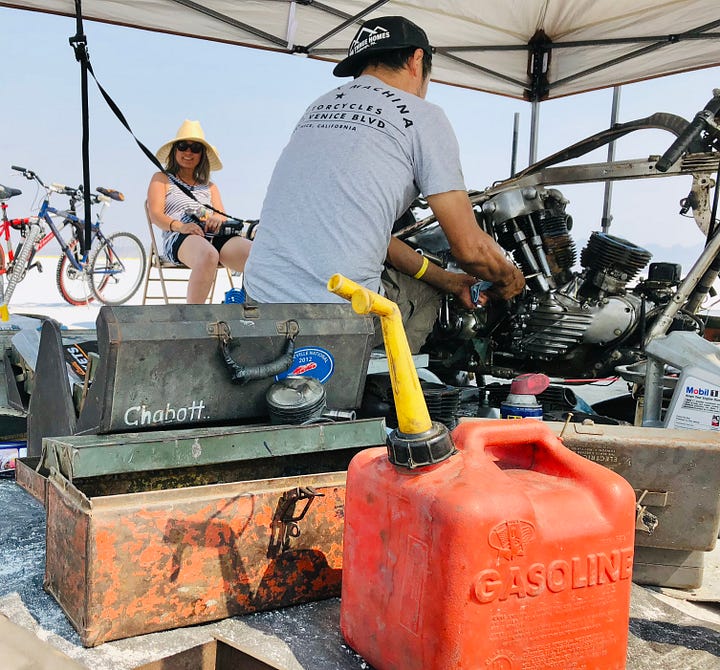
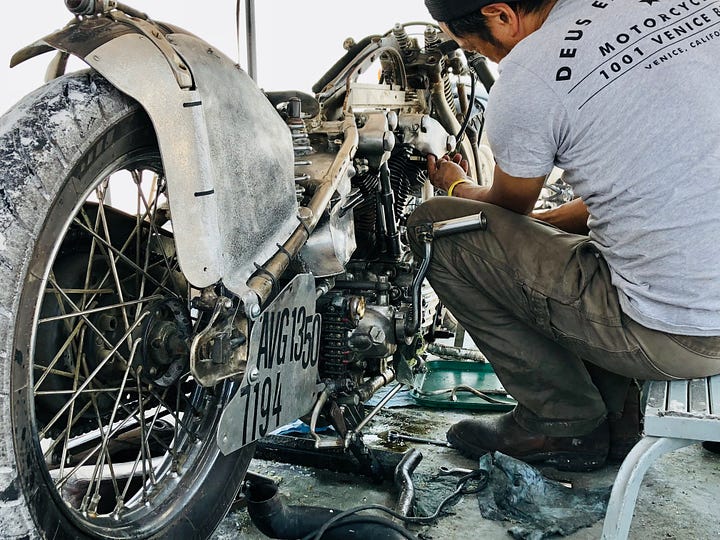
Shinya is a man of few words when it comes to describing his dedication to building and racing motorcycles. I spoke to his crew chief and wife Ayumi Yamakita (Ayu) recently to find out more about their Bonneville motivation.
How many times have you and Shinya had bikes on the Bonneville Salt Flats? Which has been your best year so far?
We started to race on the salt flats in 2007 and have been there every year since, except for 2014 and 2015 (canceled due to weather) and 2020 (Covid-19). So 12 times? It was canceled due to weather last year, too but we were there.
Well, every year is different from the other since we've raced three different machines and we enjoyed every and each year. We remember that the salt condition was superb in the first several years.
Speedwise, we were so close to the record in some years not so close in other years but that's not the only reason why we love racing there so again, it's hard to pick the best year.
How do you decide which bike to prepare, and when does that process begin leading up to Speed Week?
Now we race two bikes, one is a 1947 Harley Knucklehead and the other one is a 1956 Triumph. The land speed racing season at El Mirage dry lake starts in May so we start preparing both machines before that and keep preparing until Speed Week.
The class record for the Triumph is within grasp, so we are very excited about it and Shinya applies more wild ideas to it. The class record for the Knuckle is a long way to go to break but we keep breaking our own records every year so far, so that's another way to appreciate it. Race prep is time-consuming and painstaking work sometimes, but at the same time, it's meditation for Shinya, just focusing on making the machines go fast.
What motivates you both to keep returning to the salt each season?
Very strange, but it is just addictive. Once you get on the salt flats, you keep coming back and you cannot explain why in words. That's what all our racemates say and we totally agree. We really don't know what motivates us but when we get back from the salt flats, we get the urge to go back out there and race again. Very strange.
History of the Bonneville Salt Flats
The Bonneville Salt Flats Race Track – listed on the National Register of Historic Places – was first used for motor sports in 1912, but did not become truly popular until the 1930s, when Ab Jenkins and Sir Malcolm Campbell competed to set land speed records.
Jenkins – the 24th mayor of Salt Lake City between 1940 and 1944 and a home building contractor – was a professional race car driver whose interest in motorsports began with racing motorcycles on dirt tracks, leading to a deep interest in land speed records at the Bonneville Salt Flats. He was instrumental in establishing Bonneville as a location for such events, and in attracting overseas drivers such as George Eyston and Sir Malcolm Campbell to compete there.
His racing exploits were so prolific Pontiac named its popular 1957 model the Bonneville after he passed away from a heart attack in 1956. Jenkins Peak, located north of the Bonneville Speedway and prominently visible, was named in his honor in 1960.
A year before, the Triumph T120 (a tuned double carburetor version of the Triumph Tiger T110) came to be known as the Bonneville, based on Johnny Allen’s record 193 mph run in a 650cc Triumph-powered streamliner at the Salt Flats in 1956.
The T120 Bonneville was unveiled at the Earls Court Bike Show, and went on sale in 1959.
Our History With Triumph Bonnevilles
Our motorcycle-mad family has owned several variations of the famous Triumph Bonneville, beginning with the custom black and blue 2007 Thruxton scrambler Jean bought from Arroyo Grande’s favorite son Bryan Thompson in December 2018.
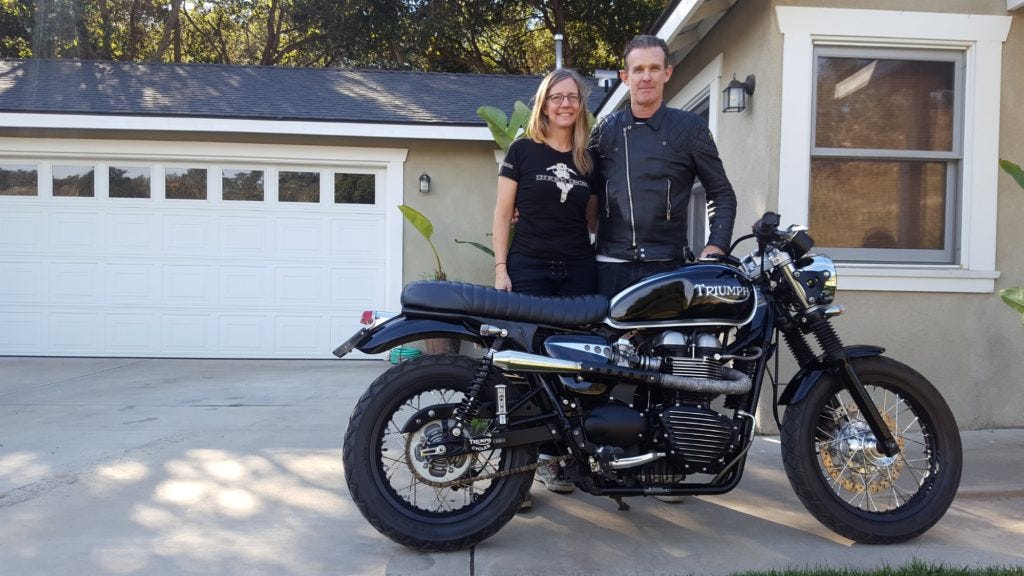
Not wanting to be left out, I traded my 2004 Moto Guzzi V11 Sport Ballabio for a red and white 2007 Thruxton a few months later. In time those bikes went to new garages, and after sampling a 2013 Bonneville T100, Jean settled upon her current ride, a 2020 Bonneville Speedmaster, the only new vehicle we’ve purchased in our 37 years together.
Two small glass jars are displayed prominently on our living room bookshelf, containing Bonneville salt as our simple memento. Do you have a personal Bonneville Salt Flats story to share?

